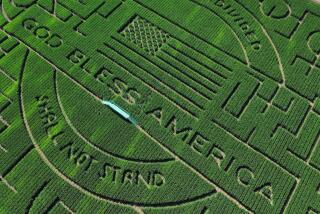A Bumper Crop of Art Grows on Kansas Farm : Stan Herd’s ‘Sunflower’ Canvas--a 20-Acre Field--Is Recognizable Only From an Airplane
- Share via
EUDORA, Kan. — Every day for several weeks light airplanes and helicopters have been circling over Junior and Elizabeth Neis’ 1,000-acre farm on the outskirts of this small Kansas town.
And passengers in commercial airliners that fly over the farm on landing patterns into the Kansas City Airport have been oohing and aahing at the view.
What they see appears to be a gigantic vase containing three huge sunflowers standing on a quilt-covered table top in the midst of acres and acres of wheat.
It is a 20-acre, living, growing mural the size of 14 football fields created from row after row of sunflowers, soybeans, clover and plowed earth in vivid yellow, rust, green and earthen colors. The vase is 400 feet tall, the sunflowers each 400 feet in circumference.
Art on Epic Scale
It’s the latest work of crop art by Stan Herd of nearby Lawrence.
Herd, 36, who normally does conventional-sized paintings of rural Kansas landscapes and murals depicting scenes of the Old West, in the last five years has created three works of crop art so immense that it has been possible to view them only from the air.
In 1981 the crop artist did a 160-acre portrait of Kiowa Indian chief Satanta out of wheat and stubble. Two years later he did a 160-acre portrait of Will Rogers in wheat, milo and plowed earth. Both were on farms near Dodge City.
“I grew up on a Protection, Kan., farm. I’m the product of the land, a plowboy at heart,” the artist said. “Crop art gets me out of the city, back to my roots.”
He said crop art “satisfies the terrible pangs and powerful pull of wanting to be back on a combine, to be sitting on a tractor again. I missthe smell of the earth out in the country. I miss being in the fields when storms move in, miss watching hawks soar overhead, miss seeing coyotes.”
It took him a month and a half, off and on, to do the vase with the sunflowers, which he calls “Kansas Still Life.” It is his personal birthday greeting to Kansas, the Sunflower state, which is celebrating its 125th anniversary.
The earthen pot, he noted, represents the Kansa Indians, “the people of the Southwind,” who gave the state its name.
“As an artist I did it all, plowed the field, planted the crops, fertilized it, irrigated it, cut it.
“I get goose bumps whenever I fly over it,” Herd said as the Cessna 172 circled over “Kansas Still Life” 1,000 feet above ground.
“It looks different every time. I see it from the air once or twice a week. On the ground it looks just like another 20 acres of crops. Last time I was up the soybeans were green. Wow! Look at them now. What great fall colors.”
The soybeans, forming a backdrop for the vase in the lines on the table-top quilt, were turning to rust color. The sunflowers no longer in bloom were brown. The clover was shades of green, the vase a variety of earthen colors.
“I always have been fascinated with patterns on farmland seen from the air,” Herd said. “There are all kinds of images on the ground. Wind blowing across wheat fields forms a myriad of flowing designs. One day out of the blue I thought maybe I should do a huge mural using crops on a farm.”
One of the artist’s heroes since childhood is the Kiowa Indian chief Satanta, known as the Great Orator of the Plains. Herd did a portrait of Satanta by plowing wheat and milo stubble and turning up the ground to form the Indian’s facial features.
He worked from a grid pattern, with each 100 feet of farmland marked off to correspond to one inch in his sketch.
Unlike his paintings and building murals, crop art so far has not made Herd any money. It costs him time and dollars.
“These huge works of art give me recognition. I have hoped all along some large corporation might see some value in what I’m doing for television commercials. But so far that hasn’t happened,” he said.
He said he has contacted officials at John F. Kennedy Airport in New York suggesting he might do a portrait of the late President the size of several football fields in the approach pattern, but has had no response.
He has thought of contacting several major airports suggesting other huge designs visible to passengers as they fly in and out.
So far, however, it has been strictly a labor of love for him.
Bonanza for Pilots
But pilot Rod Mohr, 35, based at the Lawrence Airport, said he and other light-plane and helicopter pilots in the area were experiencing “a bonanza in charters from people wanting to see the crop art at Eudora.”
For the Neis family, having a 20-acre mural has been, as Junior, 63, puts it, “just about the most exciting thing that’s ever happened around these parts.
“Airplanes circle overhead every day, sometimes three or four at a time. The entire Kansas Art Commission viewed Stan’s artwork from the sky and later visited the farm. And, we’re still earning money from crops harvested from the mural.”
In a letter Jean Kindig of Boulder, Colo., sent to her sister Elizabeth Neis, she wrote: “I never thought Junior would be a patron of the arts. . . . “
More to Read
Sign up for Essential California
The most important California stories and recommendations in your inbox every morning.
You may occasionally receive promotional content from the Los Angeles Times.













